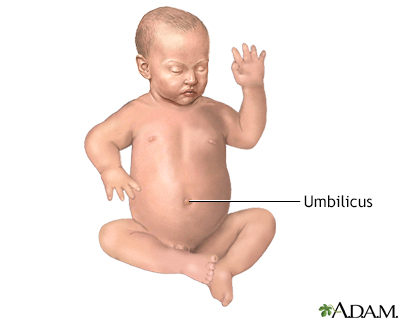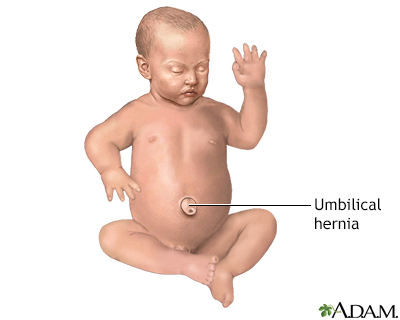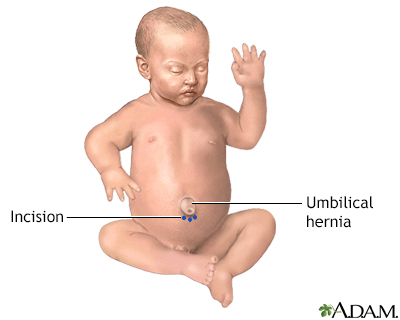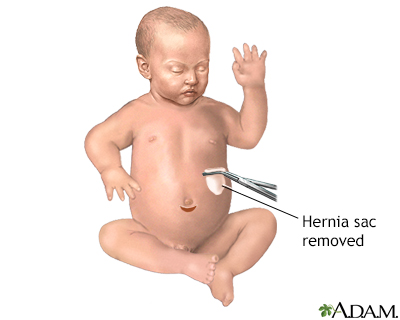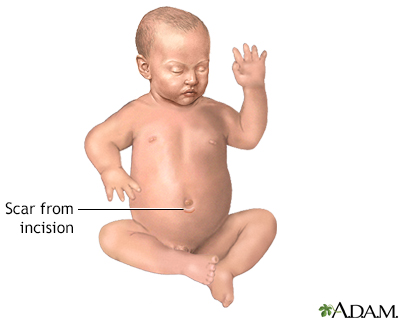Umbilical hernia repair
Umbilical hernia surgery; Umbilical herniorrhaphyUmbilical hernia repair is surgery to repair an umbilical hernia. An umbilical hernia is a sac (pouch) formed from the inner lining of your belly (abdominal cavity) that pushes through a hole in the abdominal wall at the belly button.
Umbilical hernia
An umbilical hernia is an outward bulge in the area around the belly button. It occurs when internal organs or the abdominal lining bulges through t...

Description
You will probably receive general anesthesia (asleep and pain-free) for this surgery. If your hernia is small, you may receive spinal, epidural block, or local anesthesia and medicine to relax you. If general anesthesia is not used, you will be awake but pain-free.
General anesthesia
General anesthesia is treatment with certain medicines that puts you into a deep sleep-like state so you do not feel pain during surgery. After you ...
Read Article Now Book Mark ArticleSpinal, epidural block
Spinal and epidural anesthesia are procedures that deliver medicines that numb parts of your body to block pain. They are given through shots in or ...

Your surgeon will most often make a curved surgical cut following the natural skin lines under your belly button.
- Your surgeon will find your hernia and separate it from the tissues around it. Then your surgeon will gently push the contents of the hernia (either fat or intestine) back into the abdomen.
- Strong stitches will be used to repair the hole associated with the umbilical hernia.
- Your surgeon may also place a piece of mesh over the weak area (usually not in children) to make it stronger and less likely to come back.
An umbilical hernia can also be repaired using a laparoscope. This is a thin, lighted tube that lets the surgeon see inside your belly. The scope will be inserted through one of several small cuts. The instruments will be inserted through the other cuts.
If your child is having this surgery, your surgeon will discuss the type of anesthesia your child will receive. Your surgeon will also describe how the surgery will be done.
Why the Procedure Is Performed
CHILDREN
Umbilical hernias are fairly common in children. A hernia at birth pushes the belly button out. It shows more when a baby cries because the pressure from crying makes the hernia bulge out more.
In infants, the problem is not usually treated with surgery. Many times, the umbilical hernia shrinks and closes on its own by the time a child is 3 or 4 years old.
Umbilical hernia repair may be needed in children because:
- The hernia is painful and stuck in the bulging position.
- The blood supply to the intestine is restricted.
- The hernia has not closed by age 3 or 4.
- The hernia is very large or unacceptable to parents because of how it makes their child look. Even in these cases, the surgeon will probably suggest waiting until your child is 3 or 4 to see if the hernia closes on its own since an early umbilical hernia repair is more likely to recur and exposes children to anesthesia earlier in life.
ADULTS
Umbilical hernias also occur in adults. They are seen more in overweight people and in women, especially after pregnancy. They tend to get bigger over time.
Smaller hernias with no symptoms sometimes can be watched. Surgery may pose greater risks than the hernia.
Without surgery, there is a risk that some fat or part of the intestine will get stuck (incarcerated) in the hernia and become impossible to push back in. This is usually painful. If the blood supply to this area is cut off (strangulation), urgent surgery is needed. You may experience nausea or vomiting, and the bulging area may turn blue or a darker color.
To avoid this problem, surgeons often recommend repairing umbilical hernias in adults. Surgery is also used for hernias that are getting larger or are painful. Surgery secures the weakened abdominal wall tissue (fascia) and closes any holes.
Get medical care right away if you have a painful hernia or a hernia that does not get smaller when you are lying down or that you cannot push back in.
Risks
The risks of surgery for umbilical hernia are usually very low unless the person also has other serious medical problems.
Risks of anesthesia and surgery in general are:
- Reactions to medicines or breathing problems
Breathing problems
Breathing difficulty may involve:Difficult breathing Uncomfortable breathingFeeling like you are not getting enough air
 ImageRead Article Now Book Mark Article
ImageRead Article Now Book Mark Article - Bleeding, blood clots, or infection
Bleeding
Bleeding is the loss of blood. Bleeding may be:Inside the body (internal)Outside the body (external)Bleeding may occur:Inside the body when blood le...
 ImageRead Article Now Book Mark Article
ImageRead Article Now Book Mark Article
Risks of umbilical hernia surgery include any of the following:
- Injury to the small or large intestine (rare)
- Hernia comes back (small risk)
Before the Procedure
Your surgeon or anesthesia doctor (anesthesiologist) will see you and give you instructions for you or your child.
The anesthesiologist will discuss your (or your child's) medical history to determine the right amount and type of anesthesia to use.
Tell your surgeon or nurse if:
- You are or could be pregnant.
- You are taking any medicines, including medicines, drugs, supplements, or herbs you bought without a prescription.
Planning for your surgery:
- If you have diabetes, heart disease, or other medical conditions, your surgeon may ask you to see the health care provider who treats you for these conditions.
- If you smoke, it's important to cut back or quit. Smoking can slow healing and increase the risk for blood clots. Ask your provider for help quitting smoking.
- If needed, prepare your home to make it easier to recover after surgery.
- Ask your surgeon if you need to arrange to have someone drive you home after your surgery.
During the weeks before your surgery:
- You may be asked to temporarily stop taking medicines that keep your blood from clotting. These medicines are called blood thinners. This includes over-the-counter medicines and supplements such as aspirin, ibuprofen (Advil, Motrin), naproxen (Aleve, Naprosyn), and vitamin E. Many prescription medicines are also blood thinners.
- Ask your surgeon which medicines you should still take on the day of surgery.
- Let your surgeon know about any illness you may have before your surgery. This includes COVID-19, cold, flu, fever, herpes breakout, or other illness. If you do get sick, your surgery may need to be postponed.
On the day of your surgery:
- Follow instructions about when to stop eating and drinking.
- Take the medicines your surgeon told you to take with a small sip of water.
- Arrive at the hospital on time.
After the Procedure
Most umbilical hernia repairs are done on an outpatient basis. This means you will likely go home on the same day. Some repairs may require a short hospital stay if the hernia is very large.
After surgery, your provider will monitor your vital signs (pulse, blood pressure, and breathing). You will stay in the recovery area until you are stable. Your provider will prescribe pain medicine if you need it.
Follow instructions on how to care for your or your child's incision at home. Your provider will tell you when you or your child can resume your normal activities. For adults, this will be in 2 to 4 weeks. Children can likely return to most activities right away.
Outlook (Prognosis)
There is always a chance that the hernia can come back. For healthy people, the risk of it coming back is very low.
References
Eichenwald EC. The umbilicus. In: Kliegman RM, St. Geme JW, Blum NJ, et al, eds. Nelson Textbook of Pediatrics. 22nd ed. Philadelphia, PA: Elsevier; 2025:chap 144.
Nguyen HT, McDermott K. Incisional, epigastric, and umbilical hernias. In: Cameron J, ed. Current Surgical Therapy. 14th ed. Philadelphia, PA: Elsevier; 2023:671-676.
Poulose BK, Carbonell AM, Rosen MJ. Hernias. In: Townsend CM Jr, Beauchamp RD, Evers BM, Mattox KL, eds. Sabiston Textbook of Surgery. 21st ed. St Louis, MO: Elsevier; 2022:chap 45.
Sujka JA, Holcomb GW. Umbilical and other abdominal wall hernias. In: Holcomb GW, Murphy JP, St. Peter SD, eds. Holcomb and Ashcraft's Pediatric Surgery. 7th ed. Philadelphia, PA: Elsevier; 2020:chap 49.
Review Date: 1/17/2025
Reviewed By: Robert A. Cowles, MD, Professor of Surgery (Pediatrics), Yale University School of Medicine, New Haven, CT. Review provided by VeriMed Healthcare Network. Also reviewed by David C. Dugdale, MD, Medical Director, Brenda Conaway, Editorial Director, and the A.D.A.M. Editorial team.





